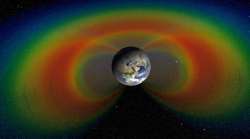NASA confirms dent in Earth's magnetic field splitting into two
The protective magnetic field around Earth is in the process of splitting into two, the National Aeronautics and Space Administration (NASA) has discovered. This small but evolving dent in the magnetic field can cause big headaches for satellites.

The protective magnetic field around Earth is in the process of splitting into two, the National Aeronautics and Space Administration (NASA) has discovered. This small but evolving dent in the magnetic field can cause big headaches for satellites. In order to highlight the importance of the Earth's magnetic field, it is pertinent to mention that it acts like a protective shield around the planet, repelling and trapping charged particles from the Sun. However, over South America and the southern Atlantic Ocean, an unusually weak spot in the field – called the South Atlantic Anomaly, or SAA – allows these particles to dip closer to the surface than normal. Particle radiation in this region can knock out onboard computers and interfere with the data collection of satellites that pass through it – a key reason why NASA scientists want to track and study the anomaly.
A weak magnetic field would mean that the particle radiation from the Sun gets closer to the Earth's surface than otherwise.
The South Atlantic Anomaly is also of interest to NASA’s Earth scientists who monitor the changes in magnetic field strength there, both for how such changes affect Earth's atmosphere and as an indicator of what's happening to Earth's magnetic fields, deep inside the globe.
Currently, the SAA creates no visible impacts on daily life on the surface. However, recent observations and forecasts show that the region is expanding westward and continuing to weaken in intensity. It is also splitting – recent data shows the anomaly’s valley, or region of minimum field strength, has split into two lobes, creating additional challenges for satellite missions.
A host of NASA scientists in geomagnetic, geophysics, and heliophysics research groups observe and model the SAA, to monitor and predict future changes – and help prepare for future challenges to satellites and humans in space.